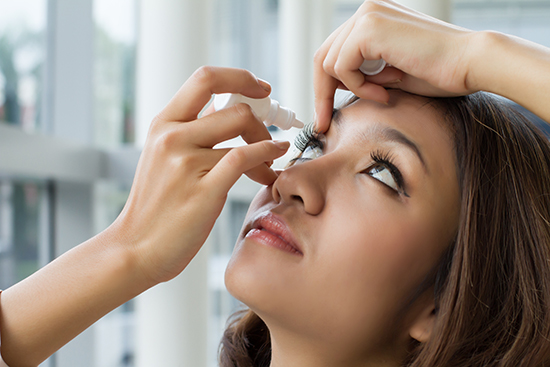
Dry Eyes/Tearing Syndrome (Keratoconjunctivitis sicca – KCS) is a general term used to describe a heterogeneous group of diseases resulting from inadequate wetting of the cornea and conjunctiva by the precorneal tear film (PCTF). Millions of people worldwide suffer from this condition. It occurs more than you might think right here in Allentown, PA.
Despite its high prevalence, the malady is not always easy to diagnose. The vast majority of dry eye Lehigh Valley, PA patients have symptoms that are mild to moderate in severity. Although these patients are genuinely suffering discomfort, objective signs of dry eyes/tearing syndrome may be missed, and without proper diagnosis, patients may not receive the attention and treatment that this condition warrants.
Often, the signs and symptoms of dry eye can be misinterpreted as evidence of other conditions such as infectious, allergic, or chemical conjunctivitis. That is why our experienced physician, Dr. Lisa Bunin, should be consulted to diagnose and prescribe a proper treatment. Our questionnaire can help determine if your symptoms range above mild and an exam is warranted.
What Causes Dry Eyes/Tearing Syndrome?
Dry eye conditions are classified as various types of abnormalities that can lead to insufficient wetting of the corneal surface. These classifications are:
- Abnormalities of the aqueous layer
- Abnormalities of the mucin layer
- Abnormalities of the lipid layer
- Abnormalities of the corneal epithelium
- Abnormalities of the lids
For some people, dry eyes are caused by a lack of adequate tears. Your tears are a complex mixture of water, fatty oils and mucus. This mixture helps make the surface of your eyes smooth and clear, and it helps protect your eyes from infection. For others, it’s increased tear evaporation and an imbalance in the makeup of your tears. Because the eyelids play such an important role in distributing the tear film, normal blinking is essential to maintaining a healthy corneal and conjunctival surface. Thus, anything that interferes with normal blinking, or anatomic abnormalities, which interfere with the complete closure of the eyelids during blinking, can result in drying of the ocular surface.
Dry Eye Patient Testimonial
Dry Eye Symptoms
The symptoms of dry eye vary considerably from one individual to another. Most patients complain of a foreign body sensation, burning and general ocular discomfort. The discomfort is typically described as a scratchy, dry, sore, gritty, smarting or burning feeling. Discomfort is the hallmark of dry eye because the cornea is richly supplied with sensory nerve fibers. A significant percentage of patients also experience photophobia and intermittent blurring or other problems with visual acuity.
Individuals with dry eye commonly remark that their eyes tire easily, making it difficult for them to read or watch television. The reason for this difficulty is that the frequency of blinking typically decreases during tasks that require concentration. As blink frequency decreases, there is more time for the tear film to evaporate. If blinking is infrequent enough, the duration of exposure will exceed the break-up-time, resulting in the formation of one or more dry spots on the corneal surface.
Contact lens intolerance can also be a symptom of dry eye. Sometimes, a patient with mild to moderate dry eye may not experience symptoms until contact lenses are fitted. The placement of a contact lens can upset the delicate balance of tear film production and distribution, leading to lens intolerance.
Dry Eyes/Tearing Treatments
Dry eyes/tearing syndrome cannot be cured, but the condition can be helped. Dr. Bunin recommends approaching the complaint several ways:
- Adding tears: over the counter artificial tears, as opposed to drops that claim to get the red out, are used several times a day to add tears to the eye.
- Increasing tear production: a new prescription medicine/eye drop called Restasis may be used to stimulate the production of tears. It is used twice a day, in addition to artificial teardrops, and takes several weeks to months to take effect.
- Slowing tear drainage out of the eye: if you want to keep water in a sink to wash dishes, you put a plug in the drain. Similarly, if you put a removable plug in the tear drainage hole (punctum) in the nasal corner of the eyelid, it will keep tears in the eye for a longer period. These plugs are easy to set while visiting Dr. Bunin in the office, and are not felt by the patient.
- Slowing tear evaporation: flaxseed oil taken in oral form (1000 mg capsules, 2-4 per day) has been shown to improve tear lipids and slow evaporation, making the eye surface more comfortable
- Cleaning the eyelids to keep extra debris and crusts from falling in and irritating the eye.
